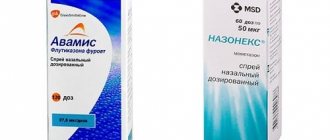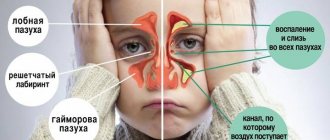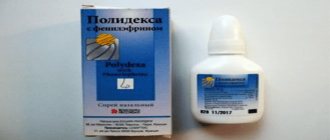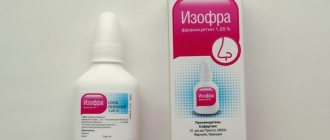Avamis and Nasonex are drugs intended for intranasal use. Both of these drugs are classified as synthetic glucocorticoids. There are general indications for prescribing Avamis or Nasonex:
- allergic rhinitis,
- acute sinusitis,
- hay fever,
- sinusitis,
- adenoiditis,
- polyps in the nasal cavity.
Both drugs differ significantly in price: Nasonex is twice as expensive as Avamis. Despite the common mechanism of action, the drugs are not interchangeable. What is better – Avamis or Nasonex – should be decided by the doctor in each specific situation. The choice of drug depends on the course of the disease, age and general condition of the patient.
Active substance
The active ingredient of Avamis is fluticasone furoate. Nasonex is based on mometasone furoate. Both of these compounds are corticosteroids.
Hormonal drugs, as a rule, have an effect on the entire body. Long-term use of glucocorticoids leads to a decrease in the synthesis of corticotropic hormone by the adenohypophysis. A drop in corticotropin levels causes a decrease in the synthesis of hormones by the adrenal cortex. There is a need for constant intake of exogenous glucocorticoids. The difference between the drugs Avamis and Nasonex from systemic drugs is that they are intended for local use. Medicines enter the blood in such small quantities that their concentration cannot be determined in a laboratory blood test. The risk of side effects is minimized.
The drugs suppress the metabolism of arachidonic acid, inhibit the release of pro-inflammatory tissue mediators, and reduce tissue swelling. The migration of lymphocytes to the site of inflammation slows down. The effects produced by the substances are so similar that many non-specialists find it difficult to understand what the difference is between Avamis and Nasonex.
The drug Nasonex is weaker than Avamis. The concentration of the active substance in it is lower. In addition, fluticasone furoate has a stronger effect on body tissues than mometasone furoate. Nasonex, as a more gentle remedy, can be used for prevention. For example, people suffering from hay fever are recommended to start taking the medicine two weeks before the plants that cause allergies begin to bloom.
Use of Avamis for adenoids: reviews and recommendations
Inflammation of the tonsils cannot be avoided without treatment. The drug Avamis copes well with inflammation and swelling. Avamis nasal spray is a more convenient dosage form to combat the disease.
The child breathes through his mouth, often catches a cold, then his hearing deteriorates, and even the shape of his face changes. Most likely these are adenoids. You can start the mechanism of their growth after any infection: flu, measles, sore throat.
The disease is based on a complete change in the tissue of the tonsils located in the pharyngeal space. At the same time, they grow very strongly, making normal nasal breathing difficult, the voice becomes nasal, and the nose is constantly stuffy. Radical treatment of inflammation is surgery. For conservative therapy, doctors recommend the new medicine Avamis.
In the process of treatment, the introduction of drugs into the nasal cavity is increasingly practiced. Avamis nasal drops are convenient to instill due to the special design of the cap. A hormonal drug for the treatment of adenoids, Avamis nasal spray, has found wider use in pediatrics. Its main purpose is to relieve manifestations of an allergic reaction on the nasal mucosa during acute and chronic inflammatory processes. The drug contains a special hormonal substance - fluticasone furoate, the content of which in one therapeutic dose reaches 7.5 mcg.
The nasal spray is available in the form of a white suspension; the bottle contains at least 30 therapeutic doses. There is an even larger packaging of the drug - bottles containing 120 therapeutic doses. The active ingredient Avamis refers to drugs that have all the properties of adrenal hormones. In addition, the drug has a therapeutic effect on the area of special receptors, reducing the inflammatory process in tissues. The drug is sprayed into the nasal cavity in an amount of 110 mcg, corresponding to one therapeutic dose, and is quickly eliminated from the patient’s body. Metabolic products undergo complete breakdown in the liver and are removed from the body through the intestines. 1% of the drug is excreted through the kidneys, and about 2% is removed with the contents of the gallbladder.
A question that arises among parents: “Avamys: a hormonal drug or not? “—should not cause a feeling of anxiety for the child’s health. When used for a long time in children over 6 years of age, the concentration of the drug in the blood did not increase, and it was not detected in the urine if taken intranasally. In older patients, a different picture was observed: there was a higher concentration of the active substance in the blood compared to younger people.
The drug should be taken regularly. The onset of the therapeutic effect begins 8 hours after administration into the nasal cavity, and the visible effect occurs after 1 - 2 days. On the first day, doctors recommend administering an initial dose of the medicine - 55 mcg, making 2 sprays once a day. For children aged 2 to 11 years, one spray once a day is enough.
Avamys is a drug similar to Nasonex. Many patients who have used Avamys to treat inflammation of the adenoids note that the drug has a local effect on the mucous membrane of the tonsils. And although it is intended for the treatment of rhinitis, it copes well with the task of relieving active inflammation and reducing swelling.
The effectiveness of the drug has not been absolutely proven to date, but it is regularly used by doctors to prevent the proliferation of adenoid tissue. Its main task is to relieve swelling; At the same time, the tonsils, which previously enlarged after the infection, become significantly smaller, but do not disappear completely
. In some cases, slight bleeding from the nose may occur in weakened patients when using the medicine for more than 1.5 months. As an individual reaction, the appearance of rash, swelling, and urticaria is observed. Pregnant women and nursing mothers should not use this hormonal drug.
“Is Avamis necessary for adenoids? “Reviews are ambiguous, but many of them indicate that in the complex process of adenoid formation, this drug affects one of its components - it reduces tissue swelling, while the resulting inflammation resolves. Many patients who used the spray and nasal drops noted a significant improvement in their health, but some, after using Avamis, experienced nosebleeds and slight ulceration of the nasal mucosa. In isolated cases, after long-term use of the drug, growth retardation was observed, which was directly related to the effect of the hormonal drug on adrenal functions, which caused their inhibition. According to many reviews, the benefits of using the medicine outweighed its disadvantages.
Adenoids are difficult to treat; the process is long. The most radical method is surgery, but there are many drugs that can stop the course of the disease. It is worth using the medicine Avamis in the fight against the disease.
How to use medications correctly
Both Avamys and Nasonex are sprays. The bottles are equipped with convenient dispensers. Before inhalation, the container with the drug must be shaken.
For treatment, adults and adolescents over 12 years of age are prescribed Nasonex one inhalation into each nostril 2 times a day. The maximum permissible dose is twice the recommended dose and is two inhalations 2 times a day. If after a few days the patient’s condition improves, the number of injections of the drug is reduced. Children from 2 to 12 years old are given one inhalation once a day.
Avamis is taken once a day. The initial dose is 2 inhalations, the maintenance dose after achieving a positive result is 1 spray into each nostril.
Medicines should be stored at a temperature no higher than 25 0 C. They cannot be frozen - at low temperatures the active substances of the drugs are destroyed and they lose their properties.
How can you cure adenoids in a child?!
They need to be removed.
Especially if the child snores at night and his hearing has become worse (he asks again), then it’s a must. Name of the drug Avamis 27.5 mcg nasal spray 120 doses. Price... Protargol.
ENT doctors do NOT know how to treat adenoids. if they are of the second degree, leave them. They usually say that 80 percent of children in MSK have such adenoids, but if there’s an emergency there, it’s the fourth. and the nasal passages are closed and then removed. and medications for home use are usually prescribed: thuja oil, protargol if green snot is prescribed Isofra, Polydexa, Miramistin.
We have deleted it. the child was suffocating at night, every breath was a feat. I no longer had the strength to suffer, no matter what I did. I ended up having to undergo surgery.
Delete. We also lost our daughter at the age of five. I know a family: my son had them removed twice, the second time they grew and affected his hearing.
to remove it surgically , but what to do? It’s even worse when you start to choke at night. What if it starts suddenly? Even scarier! It's better to delete
, but what to do? It’s even worse when you start to choke at night. What if it starts suddenly? Even scarier! It's better to delete
A friend’s daughter had it removed and grew up again (to the 4th degree) now they have moved to live outside the city + my grandmother often says they have decreased to the 2nd
Protargol definitely won’t cause any harm, but that’s not what I used. Dolphin is a very good nasal rinse. simple and convenient. and most importantly useful.
We have the same bullshit. There is no cure for this, only surgery. The problem is that grade 3-4 adenoids are removed, but here they are grade 2. And they don’t give the go-ahead for the operation! but the child is sick every month, constantly has snot, a sore throat, snores at night, and no longer has the strength! Liters of Avamis and Isofra were dripped and relieved. and then all over again! And just as you wish, the doctors were stubborn and that’s it. I understand you very much (( The sea is a general strengthening factor, like salt mines, for example. But it does not specifically affect the size of the adenoids.
The baby's nose is stuffy, although the sniffles are not particularly visible. The poor thing cannot sleep, she is capricious. Aquamaris dripped..what else did you do?
We've been having the same nonsense for three weeks now. I dripped Protargol, went to the ENT specialist, and he advised me to rinse it with tea. I and the Bacteriophage dripped, it was useless. I rinse with Aqualor, then suction with an aspirator and moisturize again. Maybe Nazivin is worth it if it’s really bad
Avamis is an indispensable assistant for allergic rhinitis. 08/31/2013 Allergy medications.
Aquamaris is not a vasoconstrictor, so just dripping it won’t help.
How old is the baby? I dropped a Kalanchoe plant on mine... it differs, but it’s not advisable until it’s a year old.... can rinse with a pear…. but also if it doesn’t work out too small…. then Nazivin will probably break through the passage... and more than aquamaris, I like salin... almost the same thing, salt solution, but more effective..
What age is the baby? You can cut the onion and place it in the crib on both sides of the pillow. It smells terrible, but it helps. The slice must be updated periodically.
Drop in any saline solution (aquamaris, etc.) and clean with cotton wool or suck with a nozzle cleaner.
This is most likely an allergy, first rinse your nose with Aqualor, then drip with Nazinex spray, it is dripped once a day at night, there is also Avamis spray, it cured us in a week, our baby also suffered from congestion, along with this, give some for 10 days I think some syrup like Zondak or Clarotodine or Claritin will help! I identified mine, but I always wash my nose with Aqualor at night.
Avamis spray naz 27.5 mcg dose 120 doses fl t st packs of cards x1 Glaxo Operations UK Limited. Pharmacy Low prices.
Nothing helped us, no rinsing, no suction, no saline solutions, and even vasoconstrictors did not help until it went away after 7 days.
Place a few drops of eucalyptus oil on your pillow before going to bed and let it breathe like an inhalation.
What spray (drops) relieves your rhinitis (runny nose)?
I don’t use ANY, so as not to spoil the mucous membrane. I blow my nose into a handkerchief or the sink in the restroom.
Avamis for children reviews, Avamis for adenoids reviews, Nasonex or Avamis what... Avamis, according to reviews, has a pronounced anti-inflammatory effect.
Vibrocil, you want to breathe and you won’t fork out for that.
Do you know that all these drops only delay getting rid of a runny nose? I don’t use anything, everything goes away on its own in 3-4 days
The most effective - WATER PROPOLIS
Plain water. I spray everything with a spray bottle - the nose immediately opens and breathes... Dry air is a disaster for the nose, especially when you have a runny nose.
Chop mustard and onion and breathe
An ENT doctor prescribed it to us, but it is hormonal and I am afraid to use it. The ENT specialist said that it relieves swelling, why can’t it be removed with some nit protargol, which is a very strong antiseptic.
Recommend good nasal drops for a persistent runny nose. It can be complex. Thank you.
Rinofluimucil
I decided to stop at protargol for now. December 3, 2011 As far as I understand, Avamis is a hormonal spray with a low amount of hormone that is excreted, I don’t know about Nazonex, but it didn’t work for us. December 16, 2011
Dig some aloe
It depends on what caused the runny nose. If you have an allergy, you can try Avamys. If you have a cold, use standard medications. Better yet, go to your local doctor.
Farmazolin helps
Bioparox is an antibiotic, if you want it to be complex. But it seems to be available only by prescription now. And so everyone has their own body, some help, some don’t. Try protargol. or better yet, go to an ENT specialist. best wishes!
Naphthyzin helps
And this time protargol 3 times a day ectericide Avamis was prescribed by ENT for 7 days. We already sprayed Avamis 2 a month ago.
Xylomepha is something. Don’t overdo it, the effect is not immediate, but it’s a quality loaf. If you spray three times at a time, your eyes will dry out.
You cannot take any drops for more than 3-5 days! ! Otherwise there will be a chronic runny nose. Consult a doctor, the causes of a runny nose are different and the treatment accordingly is also different.
Naphthyzin!
Question for ENT doctors, help!
Stop interfering with the doctors, Comrade Mommy. ENT pathology is not something to joke about.
Starting from 1 year old, we used Protargol as soon as mucus began to run out of his nose. ... Avamis.
Humidify the room, ventilate it before bed, let your child splash in the bath before bed for at least 30-40 minutes. This happens from dry air - the nasopharynx dries out.
Most likely adenoids, if possible, go to another ENT specialist, ask for a referral for an x-ray of the nasopharynx, while you can drip 3 drops of protargol. — 2 times a day lying on your back, 7 days, extend Avamis to 2 months.
Avamis and Nasonex are a good thing. Don't stop drinking for at least a month. For allergies ZODAK or Clarotadine. At night you can take a vasoconstrictor drug, NAZIVIN, for example. Remove animals from the house. Remove down pillows. Ventilate the apartment, we sleep with micro-ventilation all winter.
Antihistamines can also be used to relieve swelling of the nose. Try also moisturizing the nasal mucosa, this happens when the air at home is dry. To moisturize the mucous membrane, you can use preparations based on sea water, plus they can be used regularly and are not addictive.
Cough for a year
ENT organs, tuberculosis...
2 Protargol according to the scheme for 25 days. 3 Nasonex - 1 spray for a whole month. ... By the way, we take Avamis instead of Nasonex - it’s the same thing... don’t be scared by what it is...
How many days can Protargol solution be instilled into a child’s nose? baby 8 months old
No matter how much is needed, but enough is enough...).. there is no need to make them for the child of an allergy sufferer, who will then throughout his life drip all sorts of crap into his nose until he burns all the mucous membrane.... drop once, twice and that’s enough!...))
Tell me, who used Avamis for a child? influence. Isofra, Polydexa, Otrivin, Nazivin, Collargol, Protargol, Aqualor, Aquamaris...June 18, 2014
3-5 days
Allergic rhinitis? For three weeks, the treatment prescribed by doctors does not help.
You just visited the ENT specialist today, you just started treatment and you want instant results. It doesn't happen that way. If this treatment does not help, then you will need to look for another good ENT specialist.
AWAMIS. , spray. AVAMYS. … And as a result? Have you tried Protargol for pus in the nose?
This is what allergic rhinitis is. You have to manage to drip your nose for 3 weeks...
If a runny nose does not go away within 10 days, you need to contact a specialist... Did you take an ENT smear to confirm allergic rhinitis? Now you still need to find out what you are allergic to...
Who treated vosomotor rhinitis caused by vasoconstrictor drops? What means are effective?
Try cocaine
We have already talked about the use of Avamis nasal spray, homeopathic... But, one way or another, protargol serves as a highly effective medicine in therapy...
Protargol needs to be dripped, for several months, it is NOT a herbal vasoconstrictor, I’ll tell you straight away - it won’t pierce the nose, breathing won’t immediately improve, but it will TREAT
Half a year ago, an ENT specialist gave me a blockade, a homeopathic injection into the sinuses, and I no longer remember the drops. Contact an ENT specialist and forget about the drops; by the way, you will save a lot of money by giving up the drops. If you do a blockade, then drip Avamys once into each nostril for 10 days, 1 r per day. And you will forget about rhinitis.
Child 4 years old chronic adenoids
It’s the same with my nephew, he’s 5 for now and they told him not to do anything unless it progresses to surgery.
We were treated for three weeks with IRS-19, Avamis, Erius, Protargol, Salin, Staffilok. bacteriophage, inhalation with furacil, UFO-11 in the nose.
By the age of 14, the adenoids themselves dissolve and only the tonsils guard the throat. Personally, when I was 7-8 years old, I had an apperation to remove the adenoids, because there was inflammation and the temperature was below 40. It’s not scary, it’s done under local anesthesia, although it may be a minor shock for a child, but in any case it’s better than complications due to for temperatures
We are 5 and were prescribed Nasonex and Lymphomyosot.
We are 4 years old and we were also “treated” for six months, our daughter snored like 33 heroes, was constantly gunneling, her nose was stuffy, somewhere inside it was like a bag that was constantly fluttering, grunting... I found homeopathy: euphorbium nasal spray (sprayed for 3 weeks), and lymphomyosot drops (7-8 drops 3 times a day until the bottle runs out). Well, I washed my nose often, I washed it with saline solution from a syringe without a needle. Now we don't have a problem :)
There is only one treatment method - surgery. This is not a tumor that can resolve; they are not going anywhere. And they can cause a lot of problems; temperature is not the most unpleasant thing. And if you read somewhere that the operation was not performed, then here: a) the adenoids were not enlarged enough to require surgery; b) there was a completely different disease, for example, inflammation - then, of course, they treat it with pills.
Metabolism of drugs
Both Avamys and Nasonex, when entering the bloodstream, form complexes with plasma proteins. And the active substances of the drugs are bound and excreted by the liver. Accidental entry of one of the drugs into the esophagus during intranasal administration does not lead to significant consequences - both active substances are poorly absorbed by the walls of the gastrointestinal tract and are almost completely excreted in the feces.
No more than 2% of metabolites are excreted in the urine. It is allowed to prescribe drugs to people suffering from moderate kidney and liver diseases. For more serious pathologies, the medicine can be used only after consultation with the attending physician.
Contraindications for the drug Nasonex
Absolute contraindications for prescribing the spray are intolerance to the components of the drug and children under 2 years of age. If a child is diagnosed with acute sinusitis or a chronic disease has worsened, the medicine is used from the age of 12. For polyposis, it is recommended to use the drug from 18 years of age. Also, Nasonex should not be used in the following cases:
- if the patient has recently undergone surgery in the sinus area;
- for viral, bacterial or fungal diseases;
- when the upper respiratory tract and eyes are affected by the herpes simplex virus;
- with tuberculosis of the respiratory system.
For liver diseases, Avamis spray is more preferable. Both drugs are not given at the same time as other corticosteroids because the liver may not be able to handle large amounts of medication.
Prescription during pregnancy and lactation
No thorough clinical studies have been conducted on the effect of Avamis and Nasonex on the fetus during pregnancy. According to the recommendations of doctors and pharmacists, the use of topical glucocorticosteroids is allowed in cases where the benefit to the mother significantly outweighs the possible risk to the fetus. There is also no data on whether fluticasone furoate and mometasone furoate pass into breast milk when administered intranasally.
Pregnant women are more often prescribed Avamys. The use of the medicine by the mother is the basis for examining the child’s endocrine system - the intake of exogenous corticosteroids can provoke adrenal hypofunction.
Choice of drug for adenoiditis
According to Dr. Komarovsky, Avamis or Nasonex for adenoids is best combined with antihistamines. The use of local drugs helps alleviate the symptoms of the disease and make the patient’s life easier, but these drugs do not eliminate the cause of adenoiditis. For inflammation of the pharyngeal tonsil of an infectious nature, Avamis and Nasonex will be ineffective. Therapeutic treatment is considered appropriate for adenoiditis of the first and second degrees.
For sinusitis or adenoids, children are more often prescribed Nasonex than Avamis. The drug gradually reduces inflammation without drying out the nasal mucosa. Nasonex should not be used simultaneously with vasoconstrictors. Its long-term use does not cause dependence, but suppresses the local immune response. After stopping the medication, adenoiditis may recur.
Instructions for use for various diseases
The drug is available in pharmacies without a prescription; the packaging contains instructions for using the drug; however, it is recommended to use the nasal spray only as prescribed by a doctor. The instructions contain detailed information on the methods and doses of using Avamis for children in different age categories:
- from 2 to 11 years, 1 injection per day is prescribed,
- from 12 and older – 2 doses.
When treating children from 2 to 11 years old, it is allowed to increase the drug intake to 2 doses, but only at the discretion of the treating pediatrician in the absence of positive dynamics. Once the therapeutic effect is achieved, the dosage is reduced to the original level.
The duration of use of Avamis is determined by the pediatrician. With prolonged use, it is recommended to moisturize the nasal mucosa by instilling oil drops.
The procedure for using Avamis spray includes the following steps:
- clean your nose of mucus with a napkin (handkerchief) or aspirator,
- shake the spray until a homogeneous consistency,
- determine the spray level in the container,
- insert the tip into the nose towards the auricle, with the bottle positioned vertically,
- administer the medicine with a deep breath - one injection is equal to one dose,
- remove the nozzle from your nasal passages and exhale through your mouth,
- Carry out similar actions with the other nostril,
- protect your eyes from contact with the spray, and if this happens, rinse them with water,
- After use, close the bottle with a protective cap.
The drug must be used daily, at the same time. The effect of using drops is observed within 7-8 hours, the maximum effect occurs after 1-2 days.
The drug is prescribed to children over 2 years of age. The lack of clinical trials, as well as the specifics of use, are the main contraindications for the treatment of children under 2 years of age.
Runny nose
Allergic reactions (itching, sneezing, runny nose) to plant pollen, pet hair, and dust complicate the health of children. The use of Avamis nasal spray prevents and eliminates these symptoms. On the recommendation of the attending physician, the drug is used 15 days before the plants begin to flower. For rhinitis of bacterial origin, Avamis is used as a symptomatic remedy during antibiotic therapy.
Sinusitis
The main use of Avamis for inflammation of the maxillary sinuses is to reduce swelling of the mucous membrane, cleanse the nasal passages of mucus and purulent discharge. The effect of the medicine improves the absorption of antibacterial agents and promotes the rapid recovery of children. The use of drops for a runny nose prevents the development of an inflammatory process in the maxillary sinuses.
Adenoids
One of the complications of rhinitis is adenoiditis (we recommend reading: features of the treatment of adenoiditis in children). Children have a runny nose, mucous and purulent discharge from the nose, and hearing deteriorates. In accordance with the instructions for using Avamis nasal spray for children, for adenoids, the doctor prescribes medicine in complex therapy to eliminate swelling of the mucous membrane and restore breathing.
Side effects
The side effects of Avamis and Nasonex on the human body are quite similar and occur with the same frequency. The most dangerous are the development of immediate hypersensitivity reactions, such as:
- anaphylactic shock;
- Quincke's edema;
- bronchospasm;
- hives;
- hyperemia of the skin;
- irritation of mucous membranes;
- itching and burning.
In such cases, you must immediately stop treatment and consult an allergist. Other side effects include headache, nosebleeds, bad taste in the mouth, and ulceration of the mucous membranes. In rare cases, intraocular pressure increases and signs of perforation of the nasal septum occur.
When using the drugs Avamis and Nasonex in therapeutic doses, pathological reactions of the body occur no more often than when taking placebo. The likelihood of developing side effects increases with an overdose and use of the drug by children under 2 years of age.
Avamis and Nasonex are hormonal drugs based on glucocorticosteroids. The difference between them lies in the composition, concentration of the active substance, the number of contraindications and price. Both drugs do not have a systemic effect and enter the blood in small quantities. Pregnant women are more often prescribed Avamis, children under 12 years of age are prescribed Nasonex. The choice of medication in each specific case should be made by the attending physician.
Friends, hello everyone! Adenoids are a sore subject for many! Today I want to find out with you what is better than Avamis or Nasonex for adenoids, since there are quite a few disputes about this. Let's find out what people say about these funds.
Before getting to the main point, I would like to describe each of these drugs a little so that you understand what they consist of and what they are prescribed for.
The effectiveness of Avamys when using conservative treatment of adenoid tonsils in children
It is indisputable that the indicated remedy (“Avamys”) quickly and reliably eliminates the pathological symptoms of adenoid vegetation:
- Reduces swelling of the internal mucous surfaces in the nasopharynx by several times;
- Dramatically reduces purulent discharge of an infected mass from toxic foci of adenoids (nasal passages, nasopharynx);
- When using Avamis, a lasting result is achieved in improving free nasal breathing;
- Night snoring stops.
Otolaryngologists note the dynamics (for the better) of the transition of adenoids from 2-3 degrees of severity to the first stage. With proper adherence and precise use of the drug (without obvious overdose), practically no side complications are recorded. But for children under 2 years of age, neither Avamys nor any other hormonal drugs are used!
The action of the medication is especially effective and efficient in the initial stages of adenoid disease in children. In many cases, it is possible to normalize the clinical condition in the children's nasopharynx. Adenoid growths are canceled and the tonsils retain their wonderful functional – protective abilities.
Reviews from doctors about Avamis as a hormonal drug for adenoids in children
Despite the fact that the drug has gained wide popularity among the medical community of practicing otolaryngologists, ENT doctors, and parents of sick children, Avamis has both allies and dissenting opponents.
For example, the famous pediatrician, TV presenter, excellent specialist in childhood diseases E.O. Komarovsky believes that Avamys (as, by the way, other hormonal nasal medications for children) is an extreme measure in the treatment of adenoiditis. If there is an urgent need for active treatment of inflamed adenoids with such drugs, it means that the most important points in the child’s health have been missed.
Articles on the topic Ointment for nasal adenoiditis in children: “Oksolin” (“Oxolinic ointment”)
The parents did not pay attention to the timely minor symptoms of incipient adenoid disease or adenoid problems in the child. And, when serious pathogenesis has already appeared in the nasopharynx, then, of course, the doctor has no choice but to prescribe potent drug treatment.
Although the basic rules for the prevention of adenoiditis (rinsing the nasal passages, hardening, preventive examinations) could prevent hormonal intake, swallowing and dispersive spraying of the nasopharyngeal sector. “Avamys” is an excellent drug, the leading pediatrician personally has nothing against it, but it is better not to let your child use it.
Vladimir Yatskiv, a doctor of pediatric ENT diseases, supports his famous colleague. And he also believes that “Avamys” for adenoids in children, according to the collected materials (reviews of pediatricians, otolaryngologists), deserves a positive assessment in the therapeutic aspect of adenoiditis. And he agrees with the statements of E. Komarovsky, in which he calls for an active commitment on the part of parents to prevent adenoids in children. Do not bring the condition of the child’s nasopharynx to the point where it is necessary to “pour” medicinal compounds into the child’s growing body. Even if they are not particularly harmful, such as Avamis.
Drug Nasonex
Nasonex intranasal nasal spray produced in Belgium belongs to the group of glucocorticosteroids. The main active component of the drug is mometasone furoate.
Indications for use of Nasonex are:
• allergic rhinitis of acute and chronic nature;
• prevention of exacerbation of rhinitis and sinusitis.
According to the instructions, Nasonex can be used in patients over 2 years of age. The effectiveness of treatment is observed already on the first day of injection of the medicine.
Avamys drug
Avamys topical nasal spray was manufactured in the UK. The main active component is fluticasone furoate. This is a medicine of the glucocorticosteroid group.
The drug has a pronounced anti-inflammatory effect and is indicated for diagnosing seasonal and year-round rhinitis, sinusitis, sinusitis and adenoiditis in patients.
Treatment with Avamis is prescribed only by a doctor for patients over 2 years of age. The maximum effect of treatment is achieved if a regular regimen of use is followed.
As you can see, both drugs belong to the same pharmacological group and are indicated for identical diseases. Moreover, many patients consider them interchangeable. But this is a wrong opinion!
Each of them has its pros and cons, as well as different dosages and treatment regimens. In any case, Nasonex and Avamys are hormonal drugs, so taking them on your own is strictly prohibited.
In order to understand what is better for adenoids, Avamis or Nasonex, you need to know about the advantages and disadvantages of these drugs.
Treatment methods
In modern medicine, there are two options for treating adenoids: surgical removal and conservative treatment. The doctor determines how to treat adenoids in a child.
Parental consent is required for surgical removal. Before giving your consent, it is better to first use more gentle methods of therapy, thanks to which you can avoid surgical intervention.
Symptoms and treatment of adenoids in children are interrelated: the more pronounced the symptoms, the more advanced the stage and the more complex treatment is needed.
In the first stage, surgery is not used; properly selected complex therapy quickly produces positive results.
The doctor determines how to treat grade 2 adenoids in a child; if there is no desired result with drug therapy, surgery is prescribed.
Treatment of adenoids in children without surgery involves drug therapy, physiotherapy, homeopathy, and many resort to traditional medicine.
Drug therapy
- Antihistamines (Fenkorol, Suprastin).
- Immunomodulators (Immunal, Echinacea tincture).
- For purulent processes, antibiotics (Isofra) and sulfonamides are required.
It is also good to use local therapy:
- Vasoconstrictor medications - relieve swelling, eliminate runny nose (Tizin, Nasonex).
- Sprays, nasal drops (Avamys, Bioparox).
- Inhalations (Cedovix, Mentoclar).
| A drug | Dosage | Contraindications | price, rub. |
| FENKAROL | 5 mg 2 times a day | Diseases of the gastrointestinal tract, heart, kidneys | 200 |
| SUPRASTIN | 0.5 tablets 2 times a day | Allergies, bronchial asthma | 130 |
| IMMUNAL | 1 tablet every other day | AIDS, brain diseases, tuberculosis | 300 |
| ECHINACEA TINCTURE | 1 tsp. 2 times a day | Up to 2 years, autoimmune diseases | 100 |
| ISOFRA | 1 dose of spray 3 times a day | Allergy, kidney failure | 500 |
Thuja oil
When treating adenoids, you should not use pure 100% thuja essential oil, but homeopathic - 15%.
Thuja oil has proven to be very effective for adenoids for children. Main medicinal properties:
- A strong antiseptic with antimicrobial anti-inflammatory effect, normalizes nasal breathing.
- It improves immunity well.
- For adenoids, it well regulates chemical reactions in the epithelium of the nasopharynx and restores it.
For therapy, a pharmaceutical product is used - Thuja Oil Edas 801.
Nasonex
An anti-inflammatory and anti-allergenic drug, Nasonex, is often prescribed for adenoids in children.
It contains mometasone, a furosteroid hormone, which perfectly blocks inflammatory processes, prevents swelling and stops allergic reactions.
Before use, you must read the instructions for use for Nasonex adenoids, since there are some contraindications and side effects.
Avamis
Recently, doctors often prescribe Avamis for adenoids in children. This drug effectively relieves swelling of the nasopharyngeal mucosa and acts regardless of the stage of development. But it is prescribed as an additional drug in complex treatment.
Quite often, Avamis is prescribed for adenoids several days before surgery to relieve swelling, as well as in the postoperative period. Reviews for children with adenoids Avamis are positive.
The principle of action of Nasonex and Avamis is almost the same
Nasonex or Avamys – which is better for adenoids is difficult to say for sure. Both drugs are foreign-made and belong to hormonal drugs; they must be prescribed by a doctor.
If you have previously had surgery in the nasal area, Nasonex cannot be used; it is better to use it for preventive purposes. Avamis is not recommended for use in cases of acute respiratory viral infections.
Children's doctor Evgeniy Komarovsky considers adenoids in children to be a dangerous disease, due to which the child often suffers from other infectious diseases, such as rhinitis, sinusitis, bronchitis, otitis media and others. Therefore, at the first signs, start treatment, which will make it possible to do without surgery.
Komarovsky will tell you more about adenoids in this video:
Homeopathy
Treatment with the homeopathic method is quite long, taking up to 1.5 months. The doctor prescribes the following medications:
- Echinacea compositum – 1 injection every 7 days.
- Traumeel – 1 capsule 2 times a day.
- Lymphomyozo – 2 times a day, 10 drops.
- “Job the Baby” is a new remedy that fights adenoids very effectively.
Many doctors recommend spa treatment.
Physiotherapy
In addition to medications, the following procedures are prescribed:
- Ultraviolet irradiation.
- Helium neon laser.
- Electrophoresis with calcium chloride, Diphenhydramine.
- Ultrahigh frequency therapy.
ethnoscience
Below are the 5 most common ways to treat adenoids with folk remedies in children, but first you should definitely consult a specialist:
Recipe No. 1
1 tsp. salt, pour a liter of water and stir until dissolved, rinse with warm solution 3 times a day. Saline solution perfectly relieves swelling of the tonsils .
Recipe No. 2
Drip 4 drops of aloe juice into each nostril for 2 months.
Recipe No. 3
Dilute 20 drops of propolis tincture in 200 ml of warm water, add soda on the tip of a knife, and rinse the nasal passages with this solution 3 times a day.
It will be most effective to use sea buckthorn oil in combination or in the postoperative period.
Recipe No. 4
Sea buckthorn oil is dripped 3 drops 2 times a day for 20 days.
Recipe No. 5
Mix honey with beet juice in a ratio of 1:2 and instill 5 drops 3 times a day, the course of treatment is about 20 days.
Surgery
Surgery is performed under general or local anesthesia:
- Laser removal is performed with hot steam, which burns the adenoids.
- Endoscopic cutting is performed with a scalpel or a heated electrocoagulation loop, this prevents the formation of bleeding.
In the most advanced situations, the adenoids are removed along with the tonsils.
Treatment without surgery for grade 3 adenoids is prescribed if parents refuse surgery, but more often such therapy is unsuccessful.
There are some contraindications for the operation:
- Blood diseases.
- Infectious processes.
- Heart diseases.
- Dermatological diseases.
- Bronchial asthma.
- Low blood clotting.
- Congenital pathologies of the palate.
- Severe allergic reactions.
- Age up to 3 years (therefore, the doctor decides how to treat adenoids in a 3-year-old child in each individual case based on tests).
Operations are not performed during influenza epidemics and after preventive vaccination earlier than 30 days.
Read how to help your child undergo surgery here.
Postoperative period
An active and healthy lifestyle for a child will be the best prevention of adenoids.
After removal of adenoids, physical activity is contraindicated.
It is necessary to follow a special diet; you should not give your child solid or hot food; bathing in hot water is also prohibited..
Vasoconstrictor drugs must be used for 5 days.
The next day after removal of the adenoids in children, the temperature may increase; in this case, the child should not be given Acetylsalicylic acid, as this may cause bleeding. Vomiting blood and fever are possible.
Sometimes it happens that after removal of the adenoids the child snores, this goes away after a few days.
For prevention, it is necessary to increase the child’s immunity, follow a daily routine and proper nutrition. Eliminate diseases of the respiratory system and oral cavity in a timely manner. In addition, hardening the child’s body has a good effect.











